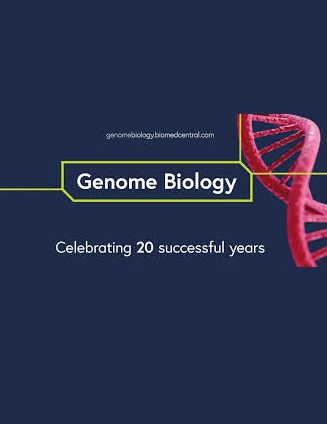Long-read detection of transposable element mobilization in the soma of hypomethylated Arabidopsis thaliana individuals
IF 10.1
1区 生物学
Q1 BIOTECHNOLOGY & APPLIED MICROBIOLOGY
引用次数: 0
Abstract
Because transposable elements (TEs) can cause heritable genetic changes, past work on TE mobility in Arabidopsis thaliana has mostly focused on new TE insertions in the germline of hypomethylated plants. It is, however, well-known that TEs can also be active in the soma, although the high-confidence detection of somatic events has been challenging. Here, we leverage the high accuracy of PacBio HiFi long reads to evaluate the somatic mobility of TEs in individuals of an A. thaliana non-reference strain lacking activity of METHYLTRANSFERASE1 (MET1), a major component of the DNA methylation maintenance machinery. Most somatically mobile families coincide with those found in germline studies of hypomethylated genotypes, although the exact TE copies differ. We also discover mobile elements that had been missed by standard TE annotation methods. Somatic TE activity is variable among individual plants, but also within TE families. Finally, our approach points to the possible involvement of alternative transposition as a cause for somatic hypermutability in a region that contains two closely spaced VANDAL21 elements. Long-read sequencing reveals widespread TE transposition in the soma of A. thaliana hypomethylated mutants. Assessing somatic instead of germline mobilization is a fast and reliable method to investigate different aspects of TE mobility at the single plant level.低甲基化拟南芥个体体细胞转座因子动员的长读检测
由于转座因子(TE)可以引起可遗传的遗传变化,过去关于拟南芥TE迁移的工作主要集中在低甲基化植物种系中的新TE插入。然而,众所周知,te也可以在体细胞中活跃,尽管对体细胞事件的高可信度检测一直具有挑战性。在这里,我们利用PacBio HiFi长读数的高精度来评估缺乏甲基转移ase1 (MET1)活性的拟南拟南植物非参考菌株个体的TEs的体细胞流动性,甲基转移ase1是DNA甲基化维持机制的主要组成部分。尽管确切的TE拷贝不同,但大多数染色体移动家族与低甲基化基因型的种系研究中发现的家族一致。我们还发现了标准TE注释方法遗漏的移动元素。体细胞TE活性在单个植物之间是可变的,但在TE科内也是可变的。最后,我们的方法指出,在包含两个紧密间隔的VANDAL21元素的区域中,可能参与替代性转位作为体细胞超突变的原因。长读测序揭示了拟南芥低甲基化突变体中广泛存在的TE转位。评估体细胞而非种系的动员是在单个植株水平上研究TE迁移的不同方面的一种快速可靠的方法。
本文章由计算机程序翻译,如有差异,请以英文原文为准。
求助全文
约1分钟内获得全文
求助全文
来源期刊

Genome Biology
Biochemistry, Genetics and Molecular Biology-Genetics
CiteScore
21.00
自引率
3.30%
发文量
241
审稿时长
2 months
期刊介绍:
Genome Biology stands as a premier platform for exceptional research across all domains of biology and biomedicine, explored through a genomic and post-genomic lens.
With an impressive impact factor of 12.3 (2022),* the journal secures its position as the 3rd-ranked research journal in the Genetics and Heredity category and the 2nd-ranked research journal in the Biotechnology and Applied Microbiology category by Thomson Reuters. Notably, Genome Biology holds the distinction of being the highest-ranked open-access journal in this category.
Our dedicated team of highly trained in-house Editors collaborates closely with our esteemed Editorial Board of international experts, ensuring the journal remains on the forefront of scientific advances and community standards. Regular engagement with researchers at conferences and institute visits underscores our commitment to staying abreast of the latest developments in the field.
 求助内容:
求助内容: 应助结果提醒方式:
应助结果提醒方式:


